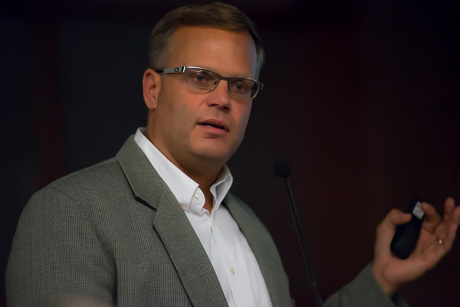
A vibrant and prosperous urban core in Batavia is vital to all of the economic development projects the Genesee County Economic Development Center is working to bring to fruition, said CEO Steve Hyde, during a presentation Monday night during Batavia's City Council meeting.
Hyde joined the discussion Monday about a projected called Batavia Path to Prosperity, or BP2. The project is being set up to take some of the fees paid by developers in future projects in the city that receive PILOTS (Payments in Lieu of Taxes) from the GCEDC and allocate half of those funds to a pool of money that can help spur development of blighted properties, properties that are part of the city's Brownfield Opportunity Area.
"My passion all along has been about growth in our community," Hyde said. "How can we build economic growth outside so it will flow back into the inside. This is an opportunity to shine a bright light on troubled areas in our community so that we have a multifaceted redevelopment strategy so that we have a path of growth for our kids."
City Manager Jason Molino kicked off the discussion by saying the program can help address poverty in the city's most economically distressed neighborhoods, increase employment opportunities nad expand the city's tax base.
In the three census tracks considered distressed, the poverty rate is 30 percent (it need be only 20 percent to be considered distressed) and the unemployment rate in excess of 7 percent is more than 2 percentage points higher than the rest of the community.
Hyde, Molino noted, is fond of saying that economic development isn't a sprint, it's a marathon. But dealing with brownfield areas, Molino said, isn't a marathon. It's a triathlon, because the issues to deal with are so big and so complex.
Often brownfield properties need a great deal of environmental remediation, which substantially increases the cost of redevelopment and scares off those who might otherwise sink their investment dollars into a commercial or mixed-use project.
BP2 will help address that issue by providing funds that can help with brownfield cleanup.
Hyde said he's seen attempts at creating other such projects around the state, but they never get off the ground because of infighting among the various taxing jurisdictions. He's encouraged by the cooperation so far from the city, county and school district.
At Monday's meeting, nary a negative question or comment came from council members, who will be asked at a future meeting to pass a resolution authorizing the city's participation in the project. Similar resolutions will need to be passed by the County Legislature and the Board of Trustees for Batavia City Schools.
Only projects within the city limits that are approved by GCEDC for PILOTs would contribute to the funds, and only brownfield projects in the three census tracks that make up the BOA could receive funds from the pool.
Under state law, development projects in all six census tracts in the city are eligible for PILOTs, even retail and commercial development, which are normally excluded, because of the highly distressed nature of three central census tracts.
The fund could be used, Molino said, to: mitigate the extraordinary cost related to hazardous material cleanup; demolish buildings that contribute to blight; rehabilitate buildings that can and should be saved; modernize infrastructure; install broadband/WiFi downtown to support economic growth initiatives; and to advance the planning and engineering of the Ellicott Trail, which will run right through the heart of the BOA, and help secure more project capital for the BOA.
Within the BOA there are five critical, strategic sites:
- Creekside, behind the Falleti Ice Arena
- The Dellapenna building on Ellicott Street
- City Centre
- The medical corridor, particularly around where the old Elks Lodge used to be
- The Harvester Center
"If over the next five years we really spent some time trying to redevelop these areas, it could have a tremendous impact on our community," Molino said.
Hyde is optimistic about our community's future, reversing the trend that has seen Genesee County go from 5,000 manufacturing jobs in 1990 to 3,500 today.
"We're on the cusp of great growth here, especially in light of last week's announcement (the new project in STAMP)," Hyde said. "The state and feds are investing in the innovation economy, especially up and down the I-90 corridor, and we've now got the largest project in the state right along that corridor."
Batavia needs to be ready for that growth and strengthening the urban core is vital to benefitting from economic development elsewhere in the county.
For every high-tech job, studies show there are five additional jobs created along the economic chain, Hyde said. Those jobs only come to Batavia if Batavia is ready for the opportunity. That means upgrading the housing, increasing office space, fixing infrastructure and "making this place as beautiful as the people who live here."
